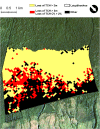Episodic Canopy Structural Transformations and Biological Invasion in a Hawaiian Forest
- PMID: 28785270
- PMCID: PMC5519564
- DOI: 10.3389/fpls.2017.01256
Episodic Canopy Structural Transformations and Biological Invasion in a Hawaiian Forest
Abstract
The remaining native forests on the Hawaiian Islands have been recognized as threatened by changing climate, increasing insect outbreak, new deadly pathogens, and growing populations of canopy structure-altering invasive species. The objective of this study was to assess long-term, net changes to upper canopy structure in sub-montane forests on the eastern slope of Mauna Kea volcano, Hawai'i, in the context of continuing climate events, insect outbreaks, and biological invasion. We used high-resolution multi-temporal Light Detection and Ranging (LiDAR) data to quantify near-decadal net changes in forest canopy height and gap distributions at a critical transition between alien invaded lowland and native sub-montane forest at the end of a recent drought and host-specific insect (Scotorythra paludicola) outbreak. We found that sub-montane forests have experienced a net loss in average canopy height, and therefore structure and aboveground carbon stock. Additionally, where invasive alien tree species co-dominate with native trees, the upper canopy structure became more homogeneous. Tracking the loss of forest canopy height and spatial variation with airborne LiDAR is a cost-effective way to monitor forest canopy health, and to track and quantify ecological impacts of invasive species through space and time.
Keywords: carnegie airborne observatory; forest change; forest gaps; invasive species; lidar; remote sensing.
Figures






References
-
- Allen C. D., Macalady A. K., Chenchouni H., Bachelet D., McDowell N., Vennetier M., et al. (2010). A global overview of drought and heat-induced tree mortality reveals emerging climate change risks for forests. For. Ecol. Manage. 259 660–684. 10.1016/j.foreco.2009.09.001 - DOI
-
- Anderegg W. R. L., Kane J. M., Anderegg L. D. L. (2013). Consequences of widespread tree mortality triggered by drought and temperature stress. Nat. Clim. Chang 3 30–36. 10.1038/nclimate1635 - DOI
-
- Asner G. P., Flint Hughes R., Varga T. A., Varga T. A., Knapp D. E., Bowdoin T. K. (2009). Environmental and biotic controls over aboveground biomass throughout a tropical rain forest. Ecosystems 12 261–278. 10.1007/s10021-008-9221-5 - DOI
LinkOut - more resources
Full Text Sources
Other Literature Sources
Miscellaneous

